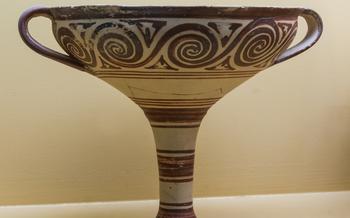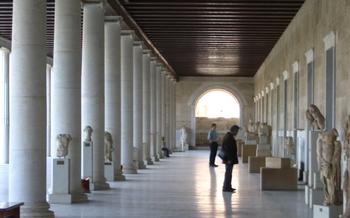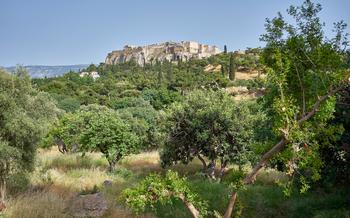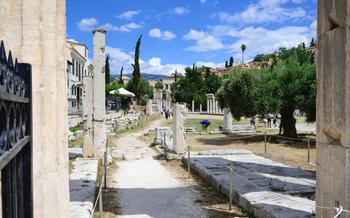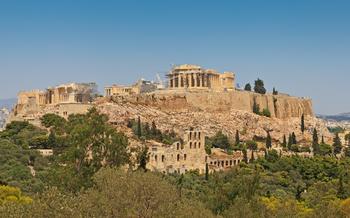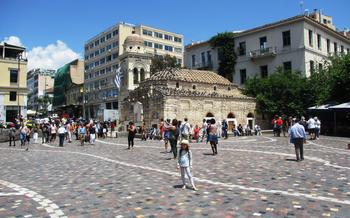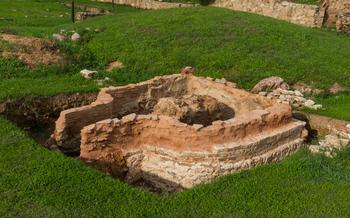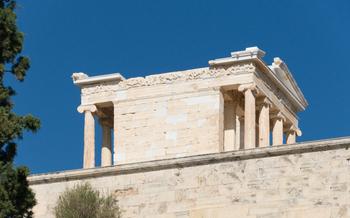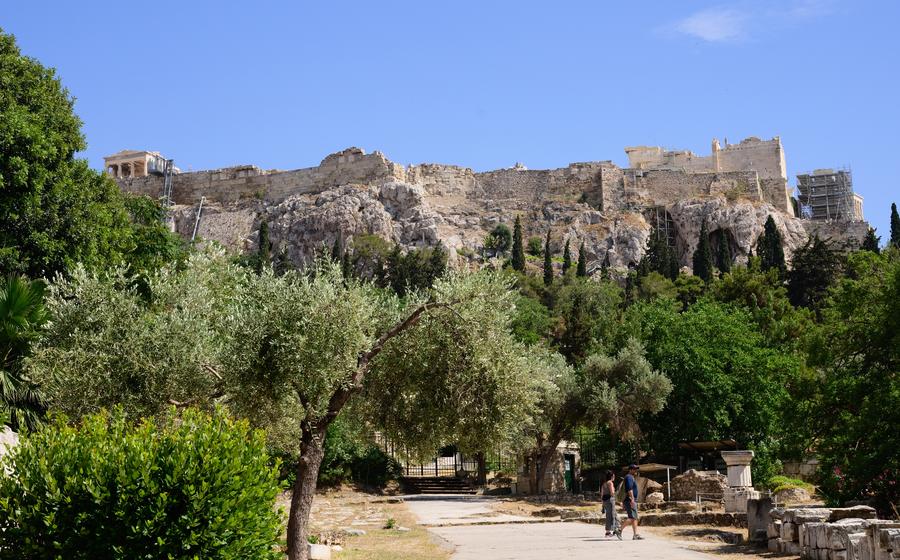
Ancient Agora of Athens
- Tracing the Footsteps of Democracy: The Birthplace of Athenian Politics
- Agora's Architectural Marvels: A Testament to Ancient Ingenuity
- Agora's Bustling Marketplace: A Hub of Economic Activity
- Agora's Religious Sanctuaries: Honoring the Divine
- Agora's Social and Cultural Crossroads: A Place for Gathering
- Agora's Philosophical Discourse: Where Ideas Flourished
- Agora's Artistic Expression: Unveiling Ancient Masterpieces
- Agora's Museum: Preserving the Legacy
- Combining History and Nature: The Agora's Serene Gardens
- Agora's Accessibility: Ensuring Inclusivity for All
- Capturing the Agora's Essence: Tips for Photography Enthusiasts
- Educational Programs and Activities: Engaging with the Agora's History
- Insider Tip: Uncrowded Serenity at the Agora
Tracing the Footsteps of Democracy: The Birthplace of Athenian Politics
The Agora was not merely a commercial center; it was the very cradle of Athenian democracy. The birthplace of politics as we know it, the Agora pulsated with the energy of political debates, assemblies, and decision-making that shaped the course of Athenian history. This vibrant public square was the beating heart of Athenian democracy, where citizens from all walks of life gathered to exercise their civic rights and responsibilities.
In the 6th century BC, the Athenian statesman Solon introduced a series of reforms that laid the foundation for Athenian democracy. These reforms shifted the locus of power from the aristocracy to the citizenry, empowering ordinary citizens to participate in the decision-making process. The Agora became the physical manifestation of this democratic transformation, hosting boisterous assemblies where citizens debated and voted on laws, declared wars, and made alliances.
The Agora's role as the birthplace of democracy has left an indelible mark on the world. Its democratic principles and practices have been adopted by countless nations, inspiring revolutions and shaping modern political systems. As we stand in the Agora today, we are reminded of the enduring power of democracy, a legacy that continues to shape our world.
Notable structures within the Agora that are associated with its political significance include the Bouleuterion, the Council House where the 500-member Council of Five Hundred met to discuss and prepare matters for the Assembly; the Tholos, a circular building that served as the meeting place of the Prytaneis, the executive committee of the Council; and the Pnyx, a hill just outside the Agora where the Assembly of all Athenian citizens convened to make decisions on important matters of state.
Agora's Architectural Marvels: A Testament to Ancient Ingenuity
The Ancient Agora of Athens is a treasure trove of architectural wonders, showcasing the ingenuity and artistry of ancient Greek builders. Among the most notable structures are the Stoa of Attalos, the Temple of Hephaestus, and the Odeon of Agrippa.
The Stoa of Attalos, meticulously reconstructed in the 1950s, stands as a testament to the grandeur of ancient Greek architecture. This two-story stoa once served as a bustling marketplace, with shops lining its colonnaded interior. Today, it houses the Museum of the Ancient Agora, where visitors can admire artifacts unearthed from the site.
The Temple of Hephaestus, also known as the Theseion, is one of the best-preserved temples in Greece. Dedicated to the god of fire and metalworking, this Doric temple was built in the 5th century BC. Its impressive size and well-preserved sculptures make it a must-see for any visitor to the Agora.
The Odeon of Agrippa, built in the 1st century BC, was a small theatre used for musical performances and recitals. Its well-preserved stage and seating area offer a glimpse into the cultural life of ancient Athens.
In addition to these major structures, the Agora is home to several other significant buildings, including the Bouleuterion (council house), the Mint, and the Prison of Socrates. Each of these buildings played a vital role in the functioning of ancient Athenian democracy and society.
Agora's Bustling Marketplace: A Hub of Economic Activity
The Ancient Agora of Athens was not merely a political and social center; it was also a thriving marketplace, a bustling hub of economic activity that played a crucial role in the economy of ancient Athens. The Agora served as a central marketplace where merchants, traders, and artisans from all over the Mediterranean region gathered to buy, sell, and exchange goods.
The economic significance of the Agora extended beyond its role as a marketplace. It was also a financial center, where money changers and bankers conducted business. The Agora was home to a mint where coins were produced, facilitating trade and commerce throughout the Athenian Empire.
The goods traded in the Agora were diverse, reflecting the vibrant commercial activity of ancient Athens. Merchants brought in grain, wine, olive oil, pottery, textiles, and other commodities from across the Mediterranean. In return, Athenian artisans and craftsmen sold their products, such as sculptures, jewelry, and weapons, to local and foreign buyers.
The Agora's unique role as a marketplace contributed to the economic prosperity of ancient Athens. It was a place where supply and demand met, prices were determined, and wealth was generated. The Agora's economic activity not only sustained the city's population but also contributed to its status as a major trading power in the ancient world.
Agora's Religious Sanctuaries: Honoring the Divine
The Ancient Agora was not merely a commercial and political center but also a deeply religious space. Dotted throughout the Agora were numerous temples and shrines dedicated to various deities, reflecting the Athenians' deep devotion to their gods.
The most prominent religious structure in the Agora is the Temple of Hephaestus, a well-preserved monument that stands as a testament to Athenian craftsmanship. This Doric temple, built in the 5th century BC, was dedicated to the divine craftsman Hephaestus and his wife Athena Ergane, the goddess of crafts and industry. The temple's intricate sculptures and imposing presence symbolize the significance of craftsmanship and skill in ancient Athenian society.
Other notable religious structures in the Agora include the Temple of Apollo Patroos, the Altar of the Twelve Gods, and the Stoa of Zeus. These sacred spaces served as venues for religious ceremonies, offerings, and prayers. The Agora's religious significance was further enhanced by the presence of numerous smaller shrines and altars, each dedicated to a specific deity or hero.
The Agora's religious sanctuaries played a crucial role in Athenian religious life. They were places where the community came together to honor their gods, seek divine guidance, and celebrate religious festivals. The Agora's religious dimension reflects the deep integration of religion into every aspect of ancient Athenian society.
Agora's Social and Cultural Crossroads: A Place for Gathering
The Agora served as a multifaceted social and cultural crossroads, fostering interactions and activities that shaped Athenian society. The marketplace buzzed with conversations, laughter, and the exchange of ideas, creating a vibrant atmosphere where people from all walks of life converged. Here, Athenians gathered to discuss politics, engage in philosophical debates, celebrate religious festivals, and witness theatrical performances.
The Agora was a place where social hierarchies were temporarily suspended, allowing for a sense of equality and camaraderie among citizens. Merchants, artisans, farmers, politicians, philosophers, and ordinary citizens mingled freely, sharing stories, experiences, and perspectives. This melting pot of social interactions played a crucial role in shaping Athenian culture, fostering a sense of community and belonging.
The Agora's cultural significance extended beyond its bustling marketplace. It was also home to theaters, shrines, and other cultural venues that hosted performances, religious ceremonies, and artistic exhibitions. These events brought people together, providing opportunities for entertainment, learning, and communal bonding. The Agora served as a hub for cultural expression, where Athenians celebrated their shared heritage and traditions.
Agora's Philosophical Discourse: Where Ideas Flourished
The Agora was not only a bustling marketplace and a center of political power but also a hotbed of philosophical discourse. It was here that some of the greatest minds of ancient Greece gathered to exchange ideas, debate theories, and challenge conventional wisdom.
Among the most notable philosophers associated with the Agora were Socrates, Plato, and Aristotle. Socrates, known for his relentless questioning and pursuit of truth, often engaged in lively debates with his fellow Athenians in the Agora. His teachings laid the foundation for Western philosophy and continue to influence thinkers to this day.
Plato, Socrates' student, established the Academy, a philosophical school that became one of the most influential institutions in ancient Greece. The Academy was located near the Agora, and Plato's teachings on metaphysics, ethics, and politics had a profound impact on Athenian thought and culture.
Aristotle, a student of Plato, founded the Lyceum, another philosophical school that rivaled the Academy. Aristotle's writings covered a wide range of subjects, including logic, physics, metaphysics, and ethics. His contributions to philosophy are immense, and his ideas have shaped Western thought for centuries.
The Agora was a fertile ground for philosophical discourse, where ideas were freely exchanged and challenged. The debates and discussions that took place in the Agora helped shape the course of philosophy and laid the foundation for modern thought.
Agora's Artistic Expression: Unveiling Ancient Masterpieces
The Ancient Agora was not only a center of commerce and political discourse but also a vibrant hub of artistic expression. Excavations within the Agora have yielded a treasure trove of artistic masterpieces that provide a glimpse into the creativity and skill of ancient Athenian artists. Statues, sculptures, pottery, and intricate mosaics have been unearthed, showcasing various styles and techniques.
One of the most striking discoveries is the Kritios Boy, a superbly crafted marble statue depicting a young athlete. Its lifelike proportions and graceful stance exemplify the transition from Archaic to Classical Greek sculpture. The Hermes of Andros, a captivating marble herm, showcases the exquisite skill of the sculptor Praxiteles, who imbued the figure with a serene and introspective expression.
The Agora also boasts a collection of beautifully preserved pottery, ranging from functional vessels to intricately decorated vases. These artifacts reveal the artistic flair and technical prowess of Athenian potters. Geometric patterns, mythological scenes, and everyday life vignettes adorn these vessels, providing insights into the artistic tastes and cultural narratives of the time.
The Agora Museum houses a significant collection of these artistic treasures, offering visitors the opportunity to admire the craftsmanship and creativity of ancient Athenian artists up close. These artifacts serve as tangible reminders of the Agora's role as a melting pot of artistic expression and a testament to the enduring legacy of Athenian artistry.
Agora's Museum: Preserving the Legacy
The Agora Museum, located within the Agora's archaeological site, serves as a treasure trove of artifacts that narrate the captivating story of ancient Athens. As you step inside, you'll be greeted by an array of well-preserved relics, including pottery, sculptures, tools, and inscriptions, each offering a glimpse into the daily lives of the city's inhabitants.
The museum's layout is designed to chronologically guide you through the Agora's rich history, from its humble beginnings as a marketplace to its transformation into the political and cultural hub of ancient Athens. Informative displays and interactive exhibits provide context and explanations, helping you delve deeper into the significance of the artifacts.
Beyond its role in preserving and showcasing the Agora's tangible heritage, the museum also plays a crucial role in educating visitors about the site's importance. Through educational programs, workshops, and guided tours, the museum aims to foster a deeper understanding of ancient Athenian culture and its lasting impact on Western civilization.
A visit to the Agora Museum is an essential complement to your exploration of the Agora archaeological site. It not only provides a comprehensive overview of the Agora's history but also offers a unique opportunity to engage with the tangible remains of this remarkable ancient city.
Combining History and Nature: The Agora's Serene Gardens
Amidst the bustling atmosphere of the ancient Agora, visitors can find solace and tranquility in the Agora's serene gardens. These picturesque green spaces, strategically situated throughout the archaeological site, offer a respite from the sun's glare and a chance to connect with nature. Carefully landscaped with native plants and flowers, the gardens serve as a beautiful backdrop to the Agora's ruins, enhancing their charm and allure.
Strolling through these tranquil gardens, visitors can admire the vibrant colors of bougainvillea cascading over ancient stone walls, inhale the sweet fragrance of jasmine, and listen to the gentle rustling of olive trees. The gardens provide a welcome oasis, inviting visitors to pause, reflect, and soak in the unique atmosphere of this historical site.
Whether seeking a moment of solitude or simply a break from exploring the ruins, the Agora's gardens offer a peaceful sanctuary. Here, visitors can sit on a shaded bench, immerse themselves in the beauty of their surroundings, and let their imaginations transport them back in time.
Agora's Accessibility: Ensuring Inclusivity for All
In its commitment to accessibility, the Ancient Agora of Athens has implemented several measures to ensure inclusivity for all visitors. Wheelchair ramps and accessible pathways have been constructed throughout the site, allowing individuals with mobility impairments to navigate the Agora's grounds with ease. Additionally, tactile signage and audio guides have been provided for visually impaired visitors, facilitating their exploration of the Agora's landmarks. To ensure a welcoming and inclusive environment, staff members are trained to assist visitors with disabilities, providing guidance and assistance as needed. Detailed accessibility information, including maps and specific details about accessible features, is readily available online and at the Agora's visitor center, empowering visitors to plan their visit accordingly. By prioritizing accessibility, the Ancient Agora of Athens demonstrates its commitment to creating a welcoming and inclusive environment that allows everyone to explore and appreciate the wonders of this ancient site.
Capturing the Agora's Essence: Tips for Photography Enthusiasts
The Agora offers a wealth of photographic opportunities, immortalizing its architectural marvels, vibrant atmosphere, and historical significance. For photography enthusiasts, capturing the Agora's essence requires careful consideration of vantage points, lighting conditions, and composition.
Begin by exploring the Agora's perimeter, seeking elevated viewpoints that provide panoramic vistas. The Agora Museum's rooftop terrace offers a stunning perspective, encompassing the entire site and the surrounding cityscape. Alternatively, climb the steps of the Stoa of Attalos for a unique vantage point overlooking the Agora's central square.
Understanding the interplay of light and shadow is crucial for successful photography. Aim to visit during the golden hours, shortly after sunrise or before sunset, when the Agora's structures are bathed in warm, diffused light. The soft, directional light accentuates the Agora's architectural details, creating striking contrasts and depth.
Compose your shots to highlight the Agora's unique features. Incorporate elements like pillars, statues, or archways to create leading lines that draw the viewer's eye into the image. Experiment with different angles and perspectives to capture the Agora's grandeur and scale.
Respect the Agora's regulations regarding photography. While tripods and professional equipment are generally permitted, using flash photography is prohibited to preserve the integrity of the site's artifacts. Adhere to these guidelines to ensure a responsible and enjoyable photography experience.
By embracing these tips, photographers can create compelling images that capture the essence of the Ancient Agora of Athens, preserving its timeless beauty and historical significance for generations to come.
Educational Programs and Activities: Engaging with the Agora's History
The Ancient Agora of Athens offers a range of educational programs and activities designed to engage visitors of all ages and enhance their understanding of this remarkable site. From guided tours led by expert archaeologists to interactive workshops and hands-on experiences, there are numerous ways to delve deeper into the Agora's history and significance.
For those seeking a comprehensive overview, guided tours provide an immersive journey through the Agora's past. Led by knowledgeable guides, these tours offer insights into the site's architecture, history, and cultural significance. Visitors can explore the Agora's iconic monuments, uncover the stories behind its ruins, and gain a deeper appreciation for its role in shaping Athenian democracy and society.
Interactive workshops and hands-on activities are particularly engaging for younger visitors. These programs allow children to explore the Agora through play and creativity, fostering a lifelong interest in history and archaeology. Activities may include pottery workshops, where children can create their own ancient Greek pottery, or interactive games that bring the Agora's stories to life.
Families can embark on a self-guided exploration with the help of educational materials available at the Agora's visitor center. These materials include maps, guidebooks, and activity sheets designed to engage children and adults alike. Families can follow suggested itineraries, play games, and complete quizzes as they explore the Agora's ruins, making learning a fun and interactive experience.
Through these educational programs and activities, the Ancient Agora of Athens becomes a living classroom, where visitors of all ages can immerse themselves in the history and culture of ancient Greece. These initiatives not only enhance the Agora experience but also contribute to the preservation and appreciation of this invaluable heritage site.
Insider Tip: Uncrowded Serenity at the Agora
In the midst of the bustling city of Athens, the Agora offers a tranquil oasis away from the crowds. While the site is undoubtedly popular, there are hidden corners and secret spots where you can escape the throngs of tourists and experience the Agora's serenity.
One insider tip is to visit early in the morning before the tour groups arrive. The Agora opens at 8 am, and this is the ideal time to wander around the ancient ruins in peace. The morning light casts a warm glow over the Agora, creating a magical atmosphere.
Another way to avoid the crowds is to visit during the off-season, which runs from November to March. During this time, the weather is still mild, but there are significantly fewer visitors. You can stroll through the Agora at your own pace, taking your time to explore the ruins and soak in the rich history.
If you're looking for a truly secluded spot, head to the northwest corner of the Agora, where you'll find the remains of the ancient Mint. This is one of the least-visited parts of the Agora, and you'll often have it all to yourself.
Whether you choose to visit early in the morning, during the off-season, or simply seek out the hidden corners, you'll be rewarded with a serene and contemplative experience at the Agora. It's the perfect place to step back in time and imagine what life was like in ancient Athens.
